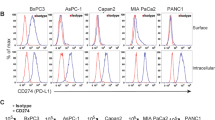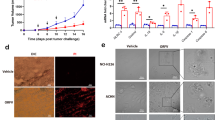Abstract
Pancreatic ductal adenocarcinoma (PDAC) represents the fourth leading cause of cancer-related death in western countries. The patients are often diagnosed in advanced metastatic stages, and the prognosis remains extremely poor with an overall 5-year survival rate less than 5 %. Currently, novel therapeutic strategies are being pursued to combat PDAC, including oncolytic viruses, either in their natural forms or armed with immunostimulatory molecules. Natural killer cells are critical players against tumours and infected cells. Recently, we showed that IL-2-activated human NK cells displayed killing activity against PDAC cells, which could further be enhanced through the infection of PDAC cells with the rodent parvovirus H-1PV. In this study, the therapeutic efficacy of parvovirus-mediated delivery of three distinct cyto/chemokines (Il-2, MCP-3/CCL7 and IP-10/CXCL10) was evaluated in xenograft models of human PDAC. We show here that activated NK and monocytic cells were found to be recruited by PDAC tumours upon infection with parvoviruses armed with IL-2 or the chemokine MCP-3/CCL7, resulting in a strong anti-tumour response.





Similar content being viewed by others
References
Schneider G, Schmid RM (2003) Genetic alterations in pancreatic carcinoma. Mol Cancer 2:15
Hecht JR, Bedford R, Abbruzzese JL, Lahoti S, Reid TR, Soetikno RM, Kirn DH, Freeman SM (2003) A phase I/II trial of intratumoral endoscopic ultrasound injection of ONYX-015 with intravenous gemcitabine in unresectable pancreatic carcinoma. Clin Cancer Res 9(2):555–561
Petrulio CA, Kaufman HL (2006) Development of the PANVAC-VF vaccine for pancreatic cancer. Exp Rev Vac 5(1):9–19. doi:10.1586/14760584.5.1.9
Gordon EM, Chan MT, Geraldino N, Lopez FF, Cornelio GH, Lorenzo CC 3rd, Levy JP, Reed RA, Liu L, Hall FL (2007) Le morte du tumour: histological features of tumor destruction in chemo-resistant cancers following intravenous infusions of pathotropic nanoparticles bearing therapeutic genes. Int J Oncol 30(6):1297–1307
Chawla SP, Chua VS, Fernandez L, Quon D, Blackwelder WC, Gordon EM, Hall FL (2010) Advanced phase I/II studies of targeted gene delivery in vivo: intravenous Rexin-G for gemcitabine-resistant metastatic pancreatic cancer. Mol Ther 18(2):435–441. doi:10.1038/mt.2009.228
Fu X, Tao L, Li M, Fisher WE, Zhang X (2006) Effective treatment of pancreatic cancer xenografts with a conditionally replicating virus derived from type 2 herpes simplex virus. Clin Cancer Res 12(10):3152–3157. doi:10.1158/1078-0432.ccr-06-0045
Kasuya H, Nishiyama Y, Nomoto S, Goshima F, Takeda S, Watanabe I, Nomura N, Shikano T, Fujii T, Kanazumi N, Nakao A (2007) Suitability of a US3-inactivated HSV mutant (L1BR1) as an oncolytic virus for pancreatic cancer therapy. Cancer Gene Ther 14(6):533–542
Liu S-H, Davis A, Li Z, Ballian N, Davis E, Wang X-P, Fisher W, Brunicardi FC (2007) Effective ablation of pancreatic cancer cells in SCID mice using systemic adenoviral RIP-TK/GCV gene therapy. J Surg Res 141(1):45–52
Rommelaere J, Geletneky K, Angelova AL, Daeffler L, Dinsart C, Kiprianova I, Schlehofer JR, Raykov Z (2010) Oncolytic parvoviruses as cancer therapeutics. Cytokine Growth Factor Rev. doi:10.1016/j.cytogfr.2010.02.011
Cornelis JJ, Becquart P, Duponchel N, Salome N, Avalosse BL, Namba M, Rommelaere J (1988) Transformation of human fibroblasts by ionizing radiation, a chemical carcinogen, or simian virus 40 correlates with an increase in susceptibility to the autonomous parvoviruses H-1 virus and minute virus of mice. J Virol 62(5):1679–1686
Dempe S, Stroh-Dege AY, Schwarz E, Rommelaere J, Dinsart C (2010) SMAD4: a predictive marker of PDAC cell permissiveness for oncolytic infection with parvovirus H-1PV. Int J Cancer 126(12):2914–2927. doi:10.1002/ijc.24992
Toolan HW, Rhode SL 3rd, Gierthy JF (1982) Inhibition of 7,12-dimethylbenz(a)anthracene-induced tumors in Syrian hamsters by prior infection with H-1 parvovirus. Cancer Res 42(7):2552–2555
Angelova AL, Aprahamian M, Grekova SP, Hajri A, Leuchs B, Giese NA, Dinsart C, Herrmann A, Balboni G, Rommelaere J, Raykov Z (2009) Improvement of gemcitabine-based therapy of pancreatic carcinoma by means of oncolytic parvovirus H-1PV. Clin Cancer Res 15(2):511–519. doi:10.1158/1078-0432.CCR-08-1088
Geletneky K, Kiprianova I, Ayache A, Koch R, Herrero YCM, Deleu L, Sommer C, Thomas N, Rommelaere J, Schlehofer JR (2010) Regression of advanced rat and human gliomas by local or systemic treatment with oncolytic parvovirus H-1 in rat models. Neuro Oncol. doi:10.1093/neuonc/noq023
Cornelis JJ, Salome N, Dinsart C, Rommelaere J (2004) Vectors based on autonomous parvoviruses: novel tools to treat cancer? J Gene Med 6(Suppl 1):S193–S202. doi:10.1002/jgm.502
Parker JC, Collins MJ, Jr., Cross SS, Rowe WP (1970) Minute virus of mice. II. Prevalence, epidemiology, and occurrence as a contaminant of transplanted tumors. J Natl Cancer Inst 45(2):305–310
Kestler J, Neeb B, Struyf S, Van Damme J, Cotmore SF, D’Abramo A, Tattersall P, Rommelaere J, Dinsart C, Cornelis JJ (1999) Cis requirements for the efficient production of recombinant DNA vectors based on autonomous parvoviruses. Hum Gene Ther 10(10):1619–1632. doi:10.1089/10430349950017626
Olijslagers S, Dege AY, Dinsart C, Voorhoeve M, Rommelaere J, Noteborn MH, Cornelis JJ (2001) Potentiation of a recombinant oncolytic parvovirus by expression of Apoptin. Cancer Gene Ther 8(12):958–965
Enderlin M, Kleinmann EV, Struyf S, Buracchi C, Vecchi A, Kinscherf R, Kiessling F, Paschek S, Sozzani S, Rommelaere J, Cornelis JJ, Van Damme J, Dinsart C (2009) TNF-alpha and the IFN-gamma-inducible protein 10 (IP-10/CXCL-10) delivered by parvoviral vectors act in synergy to induce antitumor effects in mouse glioblastoma. Cancer Gene Ther 16(2):149–160
Haag A, Menten P, Van Damme J, Dinsart C, Rommelaere J, Cornelis JJ (2000) Highly efficient transduction and expression of cytokine genes in human tumor cells by means of autonomous parvovirus vectors; generation of antitumor responses in recipient mice. Hum Gene Ther 11(4):597–609. doi:10.1089/10430340050015789
Wetzel K, Struyf S, Van Damme J, Kayser T, Vecchi A, Sozzani S, Rommelaere J, Cornelis JJ, Dinsart C (2007) MCP-3 (CCL7) delivered by parvovirus MVMp reduces tumorigenicity of mouse melanoma cells through activation of T lymphocytes and NK cells. Int J Cancer 120(6):1364–1371. doi:10.1002/ijc.22421
Giese NA, Raykov Z, DeMartino L, Vecchi A, Sozzani S, Dinsart C, Cornelis JJ, Rommelaere J (2002) Suppression of metastatic hemangiosarcoma by a parvovirus MVMp vector transducing the IP-10 chemokine into immunocompetent mice. Cancer Gene Ther 9(5):432–442. doi:10.1038/sj.cgt.7700457
Murphy PM, Baggiolini M, Charo IF, Hebert CA, Horuk R, Matsushima K, Miller LH, Oppenheim JJ, Power CA (2000) International union of pharmacology. XXII. Nomenclature for chemokine receptors. Pharmacol Rev 52(1):145–176
Kuehn R, Lelkes PI, Bloechle C, Niendorf A, Izbicki JR (1999) Angiogenesis, angiogenic growth factors, and cell adhesion molecules are upregulated in chronic pancreatic diseases: angiogenesis in chronic pancreatitis and in pancreatic cancer. Pancreas 18(1):96–103
Monti P, Marchesi F, Reni M, Mercalli A, Sordi V, Zerbi A, Balzano G, Di Carlo V, Allavena P, Piemonti L (2004) A comprehensive in vitro characterization of pancreatic ductal carcinoma cell line biological behavior and its correlation with the structural and genetic profile. Virchows Arch 445(3):236–247
Hussain F, Wang J, Ahmed R, Guest SK, Lam EW, Stamp G, El-Bahrawy M (2010) The expression of IL-8 and IL-8 receptors in pancreatic adenocarcinomas and pancreatic neuroendocrine tumours. Cytokine 49(2):134–140. doi:10.1016/j.cyto.2009.11.010
Strieter RM, Burdick MD, Gomperts BN, Belperio JA, Keane MP (2005) CXC chemokines in angiogenesis. Cytokine & growth factor reviews 16 (6):593-609. doi:10.1016/j.cytogfr.2005.04.007
Loetscher M, Gerber B, Loetscher P, Jones SA, Piali L, Clark-Lewis I, Baggiolini M, Moser B (1996) Chemokine receptor specific for IP10 and mig: structure, function, and expression in activated T-lymphocytes. J Exp Med 184(3):963–969
Taub DD, Sayers TJ, Carter CR, Ortaldo JR (1995) Alpha and beta chemokines induce NK cell migration and enhance NK-mediated cytolysis. J Immunol 155(8):3877–3888
Penna G, Sozzani S, Adorini L (2001) Cutting edge: selective usage of chemokine receptors by plasmacytoid dendritic cells. J Immunol 167(4):1862–1866
Luster AD, Leder P (1993) IP-10, a -C-X-C- chemokine, elicits a potent thymus-dependent antitumor response in vivo. J Exp Med 178(3):1057–1065
Pross HF, Lotzova E (1993) Role of natural killer cells in cancer. Nat Immun 12(4–5):279–292
Bhat R, Dempe S, Dinsart C, Rommelaere J (2011) Enhancement of NK cell anti-tumour responses using an oncolytic parvovirus. Int J Cancer 128(4):908–919. doi:10.1002/ijc.25415
Wrzesinski C, Tesfay L, Salome N, Jauniaux JC, Rommelaere J, Cornelis JJ, Dinsart C (2003) Chimeric and pseudotyped parvoviruses minimize the contamination of recombinant stocks with replication-competent viruses and identify a DNA sequence that restricts parvovirus H-1 in mouse cells. J Virol 77(6):3851–3858
Loetscher P, Seitz M, Clark-Lewis I, Baggiolini M, Moser B (1996) Activation of NK cells by CC chemokines. Chemotaxis, Ca2 + mobilization, and enzyme release. J Immunol 156(1):322–327
Polentarutti N, Allavena P, Bianchi G, Giardina G, Basile A, Sozzani S, Mantovani A, Introna M (1997) IL-2-regulated expression of the monocyte chemotactic protein-1 receptor (CCR2) in human NK cells: characterization of a predominant 3.4-kilobase transcript containing CCR2B and CCR2A sequences. J Immunol 158(6):2689–2694
Natuk RJ, Welsh RM (1987) Chemotactic effect of human recombinant interleukin 2 on mouse activated large granular lymphocytes. J Immunol 139(8):2737–2743
Allavena P, Bianchi G, Zhou D, van Damme J, Jilek P, Sozzani S, Mantovani A (1994) Induction of natural killer cell migration by monocyte chemotactic protein-1, -2 and -3. Eur J Immunol 24(12):3233–3236. doi:10.1002/eji.1830241249
Maghazachi AA, Skalhegg BS, Rolstad B, Al-Aoukaty A (1997) Interferon-inducible protein-10 and lymphotactin induce the chemotaxis and mobilization of intracellular calcium in natural killer cells through pertussis toxin-sensitive and -insensitive heterotrimeric G-proteins. FASEB J 11(10):765–774
Tannous BA, Kim D-E, Fernandez JL, Weissleder R, Breakefield XO (2005) Codon-optimized Gaussia luciferase cDNA for mammalian gene expression in culture and in vivo. Mol Ther 11(3):435–443
Van Damme J, Proost P, Lenaerts JP, Opdenakker G (1992) Structural and functional identification of two human, tumor-derived monocyte chemotactic proteins (MCP-2 and MCP-3) belonging to the chemokine family. J Exp Med 176(1):59–65
Amano H, Amano E, Santiago-Raber ML, Moll T, Martinez-Soria E, Fossati-Jimack L, Iwamoto M, Rozzo SJ, Kotzin BL, Izui S (2005) Selective expansion of a monocyte subset expressing the CD11c dendritic cell marker in the Yaa model of systemic lupus erythematosus. Arthritis Rheum 52(9):2790–2798. doi:10.1002/art.21365
Lechmann M, Berchtold S, Hauber J, Steinkasserer A (2002) CD83 on dendritic cells: more than just a marker for maturation. Trends Immunol 23(6):273–275
Cornelis JJ, Lang SI, Stroh-Dege AY, Balboni G, Dinsart C, Rommelaere J (2004) Cancer gene therapy through autonomous parvovirus-mediated gene transfer. Curr Gene Ther 4(3):249–261
Shaker MA, Younes HM (2009) Interleukin-2: evaluation of routes of administration and current delivery systems in cancer therapy. J Pharm Sci 98(7):2268–2298. doi:10.1002/jps.21596
Wagner K, Schulz P, Scholz A, Wiedenmann B, Menrad A (2008) The targeted immunocytokine L19-IL2 efficiently inhibits the growth of orthotopic pancreatic cancer. Clin Cancer Res 14(15):4951–4960. doi:10.1158/1078-0432.CCR-08-0157
Degrate L, Nobili C, Franciosi C, Caprotti R, Brivio F, Romano F, Leone BE, Trezzi R, Uggeri F (2009) Interleukin-2 immunotherapy action on innate immunity cells in peripheral blood and tumoral tissue of pancreatic adenocarcinoma patients. Langenbecks Arch Surg 394(1):115–121. doi:10.1007/s00423-008-0393-4
Fioretti F, Fradelizi D, Stoppacciaro A, Ramponi S, Ruco L, Minty A, Sozzani S, Garlanda C, Vecchi A, Mantovani A (1998) Reduced tumorigenicity and augmented leukocyte infiltration after monocyte chemotactic protein-3 (MCP-3) gene transfer: perivascular accumulation of dendritic cells in peritumoral tissue and neutrophil recruitment within the tumor. J Immunol 161(1):342–346
Jia T, Serbina NV, Brandl K, Zhong MX, Leiner IM, Charo IF, Pamer EG (2008) Additive roles for MCP-1 and MCP-3 in CCR2-mediated recruitment of inflammatory monocytes during Listeria monocytogenes infection. J Immunol 180(10):6846–6853
Acknowledgments
We are grateful to Ghislain Opdenakker for kindly providing human MCP-3 cDNA, Nathalie Salomé and Juerg Nuesch for helpful discussions, Chris Dillen, Alexandra Stroh-Dege and Claudia Plotsky for technical assistance. Laura Whiele is acknowledged for her help in the production of viral stocks. This work was supported by the Fund for Scientific Research of Flanders (F.W.O.-Vlaanderen, contract number G064809, J.V.D.), the Interuniversity Attraction Poles (I.A.P.) Program-Belgian Science Policy (J.V.D.) and the European Union 6FP EC contract INNOCHEM (J.V.D.).
Conflict of interest
The authors declare that they have no conflict of interest.
Author information
Authors and Affiliations
Corresponding author
Rights and permissions
About this article
Cite this article
Dempe, S., Lavie, M., Struyf, S. et al. Antitumoral activity of parvovirus-mediated IL-2 and MCP-3/CCL7 delivery into human pancreatic cancer: implication of leucocyte recruitment. Cancer Immunol Immunother 61, 2113–2123 (2012). https://doi.org/10.1007/s00262-012-1279-4
Received:
Accepted:
Published:
Issue Date:
DOI: https://doi.org/10.1007/s00262-012-1279-4




